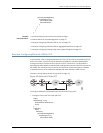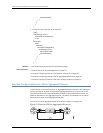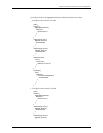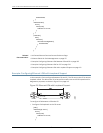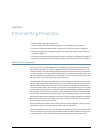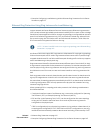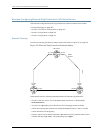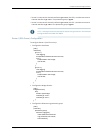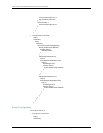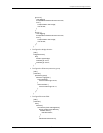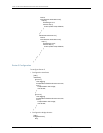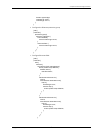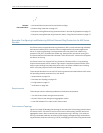
• Example: Configuring Load Balancing Within Ethernet Ring Protection for MX Series
Routers on page 154
Ethernet Ring Protection Using Ring Instances for Load Balancing
Juniper Network MX Series Ethernet Services Routers support Ethernet ring protection
(ERP) to help achieve high reliability and network stability. ERP isused in router or bridge
networks to protect against link failure. A single-ringtopology is configured that uses one
specific link called a ring protection link (RPL) to protect the whole ring. When all links
are up and running, the RPL blocks traffic and remains idle. However, if a link fails, the
RPL routes traffic to bypass the failure on the ring.
NOTE: To learn how ERP works in a single-ring topology, see “Ethernet Ring
Protection” on page 145.
MXSeriesroutersnowsupport ERPring instances.Whereas traffic ina single-ring topology
follows the same path, traffic within ring instances allows some traffic to pass through
one path while othertraffic can followa different path.Dividing trafficin thiswaysupports
traffic load balancing in the physical ring.
Ringinstancesarelike trafficchannels thatcontaindifferentsetsof virtualLANS (VLANs).
Aring instanceis responsible for the protectionof asubsetof VLANs that transporttraffic
over the physical ring. When ring instances are configured for the ring, each ring instance
should have its own RPL owner, an east and a west interface, and a ring protection link
end.
Each ring instance has a control channel and a specific data channel. A data channel is
a group of bridge domain VLAN IDs. All VLAN IDs within the same ring interface share
the same data-forwarding properties controlledby the ERP. If no data channel is defined
in the ring configuration, ERP will only operate on the physical link instead of as a ring
instance using logical links.
When operating ERP in a topology with other protocols, the following considerations
should be observed:
•
If a physical interface is part of an Ethernet ring, it cannot be configured for Spanning
Tree Protocol (STP) or Multiple Spanning Tree Protocol (MSTP).
•
ERP and Per-VLAN Spanning Tree (PVST) can be configured on the same topology
as long as PVST doesn't share the same VLAN with any Ethernet ring instance
configured on the physical port.
•
If ERP is configured only as a physical ring instance (a ring without a data channel) in
a topology also configured for PVST, ERP checks the PVST configuration on two ring
interfaces and automatically creates a data channel excluding VLANs used by PVST.
Related
Documentation
Ethernet Ring Protection on page 145•
• Example: Configuring Ethernet Ring Protection for MX Series Routers on page 148
147Copyright © 2010, Juniper Networks, Inc.
Chapter 13: Ethernet Ring Protection



